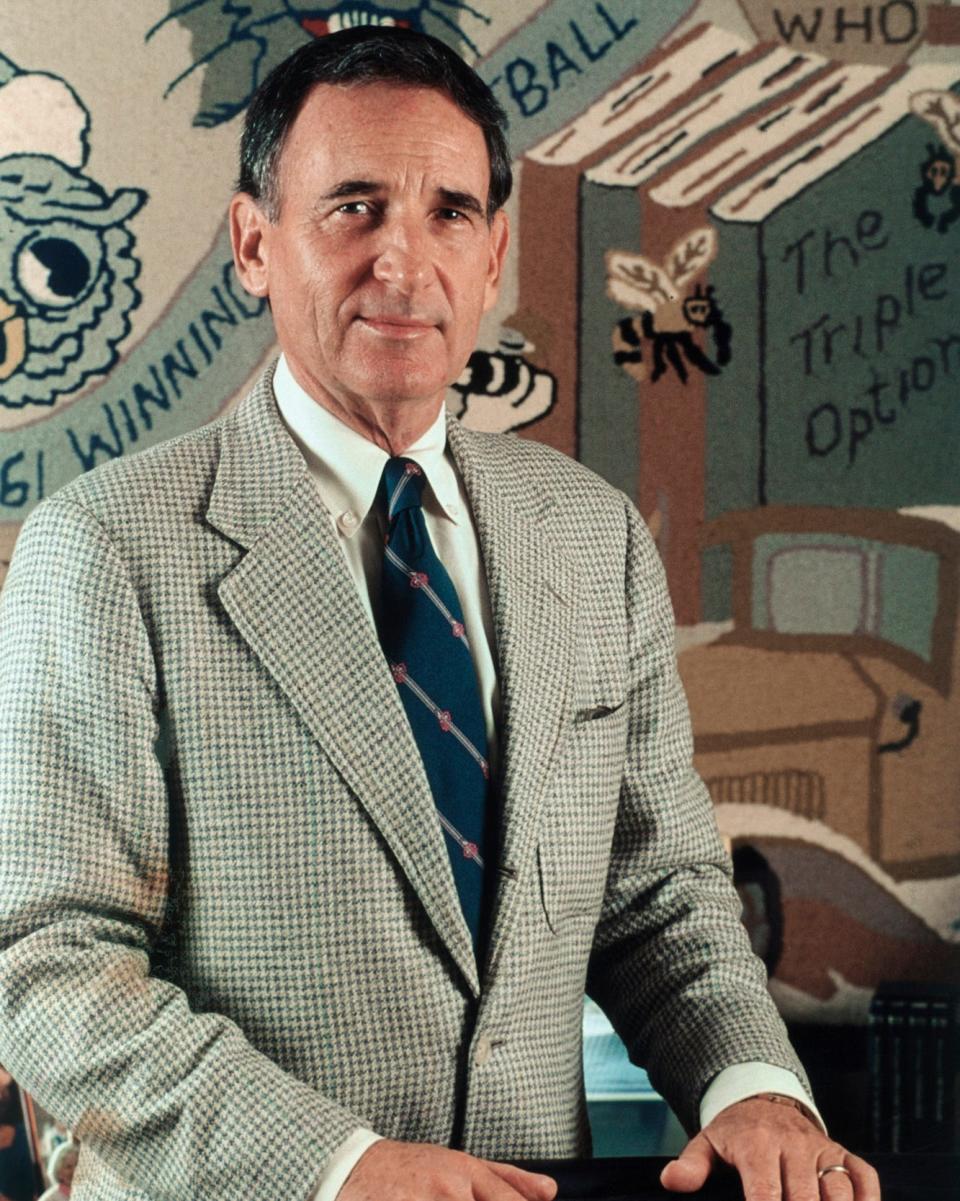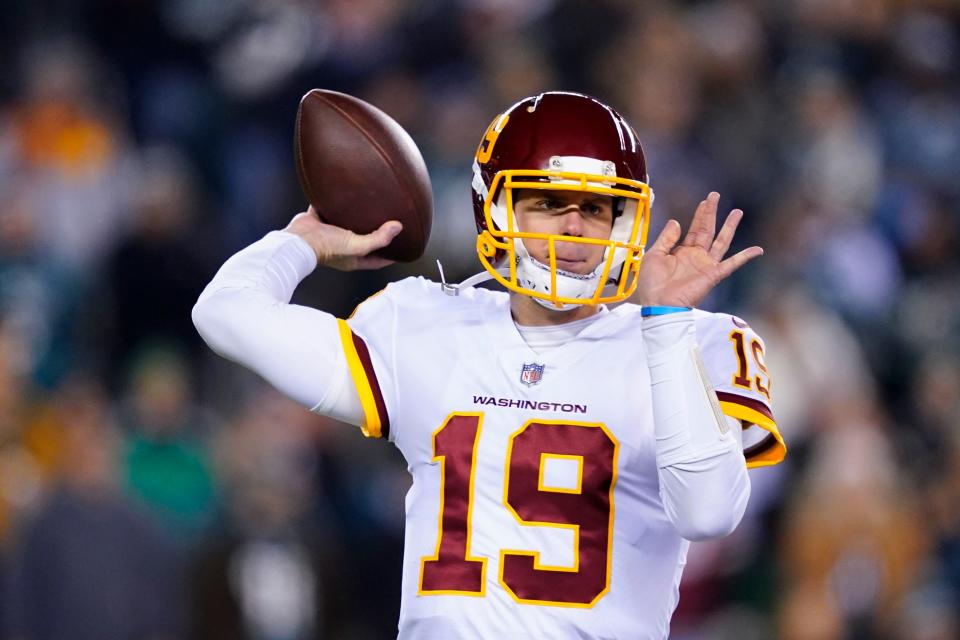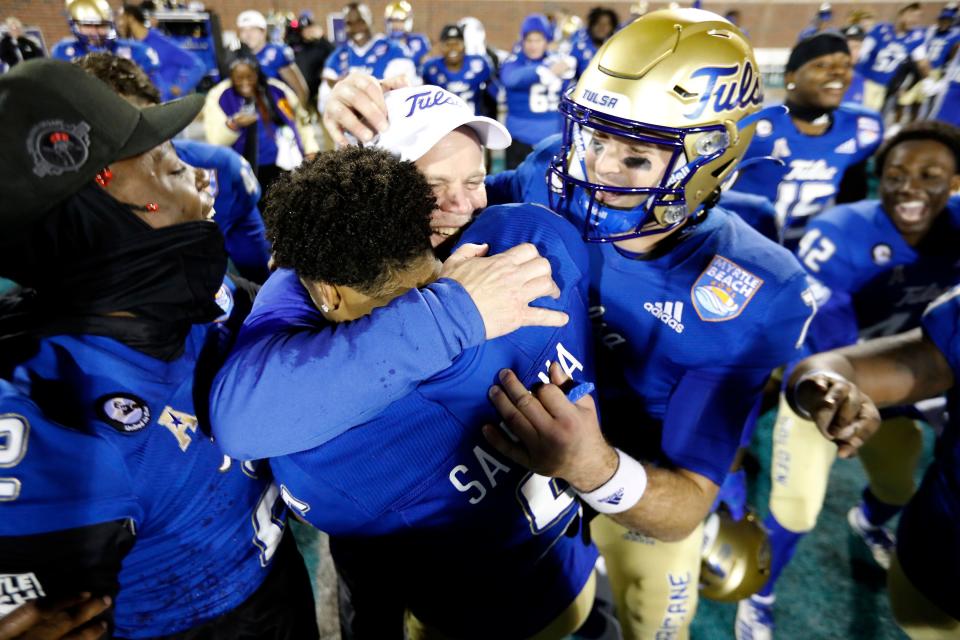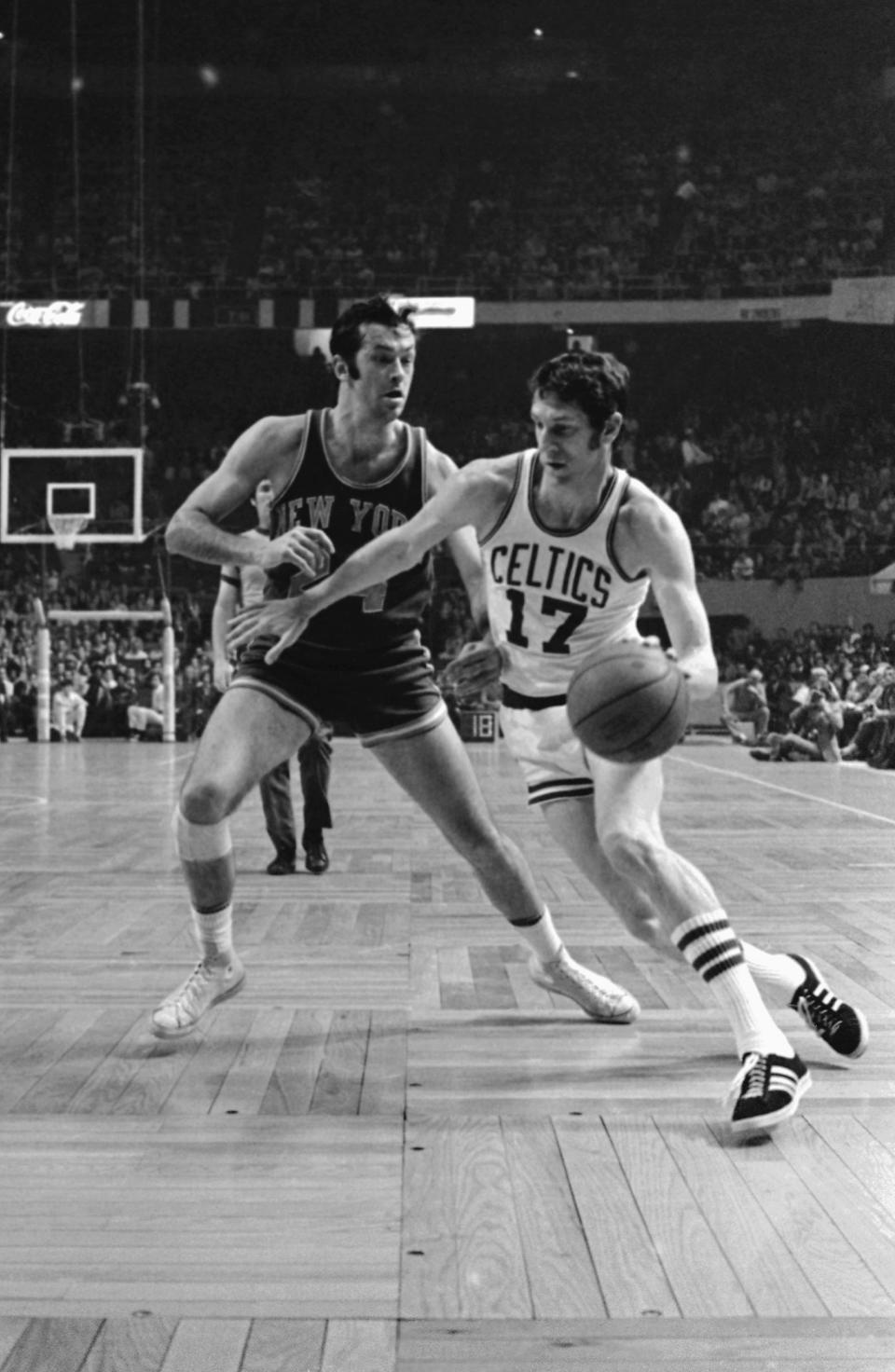Tramel's ScissorTales: How Homer Rice's five-minute decision could have changed Sooners football
- Oops!Something went wrong.Please try again later.
- Oops!Something went wrong.Please try again later.
- Oops!Something went wrong.Please try again later.
- Oops!Something went wrong.Please try again later.
Gomer Jones gave Homer Rice five minutes to make a decision. That’s not much time.
Five minutes to choose on whether to uproot your life, your family’s life, your assistant coaches’ lives, your assistant coaches’ families’ lives.
Good thing Rice had something to fall back on.
Character.
When faced with a difficult decision or a quick decision, it’s always best when you can rely on doing the right thing. Always best when you can rely on character.
Do we even remember character, as it relates to college football? Oh, it’s out there. You can find it, if you look hard enough. But like option offenses and 1:30 p.m. kickoffs, it’s hard to find.
Rice didn’t have much time to ponder Gomer Jones’ offer. But Rice didn’t need much time. He knew the right thing.
So Rice turned down the head-coaching job at the University of Oklahoma.
“I think I did the right thing,” Rice said Wednesday from his vacation condo on Marco Island, Florida.
Sixteen years ago, Rice told me that he “turned down the greatest job in America.”
Rice is 94 years old and going strong. Still teaches a class at Georgia Tech, where he was athletic director for 17 years. Hired Bobby Ross for football and Bobby Cremins for basketball. Rice is such a Yellow Jacket institution, the school recently put up a statue in his honor.
“That’s something different,” Rice said. “I didn’t know they did things like that.”

Yep, they do things like that. Especially at OU, where the statues of four landmark coaches stand. Bennie Owen. Bud Wilkinson. Barry Switzer. Bob Stoops.
But the history of Sooner football could have been changed in those five minutes back in spring 1967.
Jim Mackenzie had just finished his first season as the OU coach and had put together a staff for the ages. Switzer. Chuck Fairbanks. Larry Lacewell. Galen Hall. Pat James. Rice.
The 1966 Sooners beat Texas and Nebraska but lost to OSU and Missouri, finishing 6-4. But most sensed that Mackenzie was something special.
In December ‘66, Rice left to become head coach at the University of Cincinnati, just across the Ohio River from his Kentucky hometown.
And four months later, Mackenzie died of a heart attack at age 37.
Hence Jones’ call to Rice. Jones was OU’s athletic director. He had spent 17 years as Bud Wilkinson’s chief lieutenant, then two seasons as the Sooner head coach.
From George Lynn Cross’ Presidents Can’t Punt, we know that the OU regents were of a mind to open a nationwide search, but Cross believed stability was necessary and named Fairbanks head coach by executive order. The regents accepted Fairbanks as an interim coach, but in 1967, the Sooners went 10-1, finished No. 2 in the nation and all opposition was gone.
But before Cross named Fairbanks, Rice says he was given five minutes to decide to return to the staff he had just left.
These days, coaches have no conscience. They break contracts and gut staffs. They take a job, then two weeks later leave, when a better job comes along. Chain gangs display more character.
But in those five minutes, Rice quickly rationalized his thoughts. He knew he would have to keep Mackenzie’s Sooner staff intact.
If Rice left Cincinnati, he didn’t know what would happen to his new Bearcat coaches.
“That’s why I turned it down,” Rice said.
Fairbanks became coach, Switzer eventually succeeded Fairbanks and you know the rest, including a statue of Switzer.
It all worked out well for OU football.
But it all worked out well for Homer Rice. Oh, he didn’t turn Cincinnati football into a power (though he’s a fan of the Bearcats, about to play Alabama in the Cotton Bowl national semifinal). But Rice has had an extraordinary administrative career.
In two years at Cincinnati, Rice’s teams went 8-10-1. Then Rice became athletic director at North Carolina, where he stayed seven years. Rice returned to coaching at Rice University in the Southwest Conference for 1976-77, then the National Football League came calling.
Late in World War II, an 18-year-old Rice joined the service and was stationed at Great Lakes Naval Station, where he played catcher on the baseball team and caught a pitcher of some note, Cleveland Indians all-star Bob Feller.
“He could throw a fastball 100 mph, and I had to catch him,” Rice said. “With a little old mitt with a sponge in it.”
Rice said he always would call for a curve or a changeup, and Feller always would shake him off. Finally came the fastball. “He’d hit right square in the mitt, knock me back on my back, he was so strong,” Rice said.
The batboy on that Greak Lake Naval team was 10-year-old Mike Brown, who today is the owner of the Cincinnati Bengals. Brown’s father, Paul, founded the Bengals in 1968 and coached Ohio State from 1941-43 before entering the military himself. Paul Brown coached the Great Lakes Naval football team.
There, Rice met Paul Brown and fellow football coach Blanton Collier.
“Both became my mentors,” Rice said.
In 1962, after a 10-year high school coaching career, Rice was hired by Collier as the University of Kentucky offensive coordinator.
In 1978, Rice was hired by Paul Brown to coach the Bengals. Rice went 8-19 with the Bengals, then found his calling, as the athletic director at Georgia Tech. Rice developed and implemented the Total Person Program at Tech, and it has become the model for the NCAA Life Skills Program that is prevalent throughout the NCAA.
And Rice remains a Georgia Tech icon, 24 years after his retirement.
Rice spent just the one year in Oklahoma but remains a fan. His grandson attended OU. While at OU, Rice helped implement a Fellowship of Christian Athletes program and even went down to Texas to discuss the triple option with Darrell Royal, who was considering implementing with the Longhorns what became the wishbone. Rice had become something of an expert in the triple option with a passing twist.
“Everything was great,” Rice said. “I always follow the Sooners. See what’s going on there. That was a pretty good staff we had at that time. I knew he (Mackenzie) was going to get it going. I thought so much of him. I thought he was going to be one of the great coaches of our time.”
Chuck Bowman, who played at OU under Wilkinson and became an FCA legend in Oklahoma, is a long-time friend of Rice’s.
“I've often wondered if Homer had taken the OU job how things would be in Norman today,” Bowman said. “Something we will never know.”
But we do know what kind of character Rice had. Uncommon in the modern football world.
'Whole world is turned upside down': How has OU's bowl prep gone with staff changes and uncertainty?

Garrett Gilbert no longer a punchline
Garrett Gilbert’s name long has been a punchline, on both sides of the Red River Rivalry.
It’s time for the punchline to stop.
Gilbert was the emergency quarterback for Washington on Tuesday in the rescheduled NFL game against the Philadelphia Eagles.
The Eagles won 27-17, but Gilbert acquitted himself remarkably well, considering he first walked into the Washington football complex on Friday morning.
Covid knocked out Washington quarterbacks Taylor Heinicke and Kyle Allen, and coach Ron Rivera was in desperate need of a quarterback. So Washington signed Gilbert off the New England Patriot practice squad, and Gilbert was thrown to the wolves on Tuesday night.
Gilbert survived the wolves. He completed 20 of 31 passes for 194 yards, with no touchdowns but no interceptions. Washington had an early 10-0 lead but eventually was overtaken by Philadelphia.
And Gilbert had a similar experience a year ago. The Dallas Cowboys signed Gilbert off the Browns’ practice squad on October 12, when QB Dax Prescott was injured, and on November 7, Dallas started Gilbert against Pittsburgh, due to Andy Dalton’s injury and Ben DiNucci’s ineffectiveness.
Gilbert completed 21 of 38 passes for 243 yards, one touchdown and one interception, as Dallas lost to Pittsburgh 24-19.
In both games, Gilbert showed no signs of being a budding star. But he was a consummate professional, handling a new offense with poise and moving the offense quite well, considering the circumstances.

And that’s the sum total of Gilbert’s NFL experience, other than six passes in mopup duty in 2018 and 2019.
The guy is a good quarterback. A professional quarterback. And that’s not what anyone thought after his experience at the University of Texas.
Gilbert was a local hero, leading Lake Travis to consecutive state championships. Lake Travis is a quarterback factory that later begat Baker Mayfield.
Gilbert went to UT amid great fanfare and was quite resilient in the 2009 national championship game as a true freshman. After Colt McCoy was knocked out of the game early against Alabama, Gilbert kept the Longhorns in it. His numbers were awful – 15 of 40 passing, five turnovers – but that Bama defense was a roving pack of monsters.
Gilbert made a bunch of big plays against Bama and rallied Texas to within 24-21 in the second half before the Crimson Tide won 37-21.
Then in 2010, Texas football cratered, going 5-7 and setting off a malaise that has not ended. When 2011 didn’t start much better, Gilbert was benched in favor of David Ash and Case McCoy. Gilbert soon enough underwent surgery and transferred.
In two years at Southern Methodist, Gilbert played well, was drafted in the sixth round by the Los Angeles Rams and began a nomadic NFL career that has reaped only the two emergency starts.
But the idea hatched that Gilbert was some kind of Texas bust. History has proven that the Longhorns’ problems go far beyond one quarterback or one coach.
In fact, watching Gilbert against the Eagles on Tuesday night meant even more indictment of Longhorn football. If a college team doesn’t win with a guy like that at quarterback, that’s a program failure.
History has shown that Gilbert is a gamer, ready for duty on short notice, be it against Alabama or the Philadelphia Eagles, with big stakes.
I don’t know if Gilbert ever will get another shot. I assume Allen or Heinecke will start for Washington on Sunday night at Dallas.
But Gilbert earned his chops against the Eagles. He’s not a bust. He’s an NFL quarterback, and there aren’t many of those guys on Planet Earth.
'We love adversity': Tulsa rolls past Old Dominion in Myrtle Beach Bowl after giving up TD on opening kickoff

More: Tramel's ScissorTales: Only the NFL can save the bowls from the opt-out scourge
Tulsa rallies for solid season
Tulsa’s season opened with a stunning loss to Division I-AA Cal-Davis, and Tulsa’s bowl game opened with a 100-yard kickoff return by Old Dominion’s LaMareon James.
The Golden Hurricane recovered from both.
TU rallied from a 3-6 record to become bowl eligible, then beat ODU 30-17 to win the Myrtle Beach Bowl on Monday and finish with a 7-6 record. The Hurricane hadn’t posted back-to-back winning seasons since 2011 and 2012, when it went 10-3 and 8-5, respectively.
“We pushed each other to be better each and every day, and guys just continued to work and grind,” Tulsa coach Philip Montgomery said. “This team, maybe as much as anybody has since we’ve been here, earned this season and earned this championship.”
Well, championship is a little strong. Bowl games are non-conference matchups played at neutral sites. Good wins, yes. Championships, not particularly.
But a game like the Myrtle Beach Bowl was a nice reward for Tulsa and a good way to finish off a season that could have gone sideways fast.
After that loss to Cal-Davis, Montgomery quickly regrouped his Golden Hurricane, which played tough the next two weeks, losing 28-23 at OSU and 41-20 at Ohio State, with the latter scoring two touchdowns in the final 3½ minutes to put away Tulsa. Later in the year, Tulsa lost 27-20 at Cincinnati.
The Cowboys, Buckeyes and Bearcats all are ranked in the top 10 and are in the Fiesta, Rose and Cotton bowls, respectively.
So Tulsa proved itself a quality team, even if the Golden Hurricane didn’t make the national impact it did during the Covid season of a year ago, when TU took a 6-1 record into the American Conference championship game at Cincinnati and lost 27-24 on a last-play field goal.
“This team is really, really good if we play the way we played the past four games,” said quarterback Brin Davis, who completed 22 of 34 passes for 285 yards and two touchdowns. “I’m sure we’ll be talking about it all offseason, how well we ended and how we can just keep that success going into next season.
“I’ve already looked at the schedule … so I’m already focused on next season and how we can use this momentum to help us win a lot more games next year.”
Tulsa’s 2022 non-conference schedule is not particularly easy. The Golden Hurricane plays at Wyoming (7-6 this season) and Ole Miss, and TU hosts Mid-American Conference champion Northern Illinois and Division I-AA power Jacksonville State. Then Tulsa has its typical slate in the American Conference, league which in ‘22 still will include Big 12-bound Cincinnati, Houston and Central Florida.
The kicking game put Tulsa in a bind against Old Dominion, a 6-6 team from Conference USA. In addition to the opening kickoff returned for a Monarch touchdown, Tulsa gave up third-quarter field position when punter Lachlan Wilson panicked on 4th-and-16 from midfield. Wilson thought he was under more pressure than he was and scrambled right. Then he thought he had more running room than he did and decided to run instead of kick on the run. He lost a yard, and Old Dominion had life despite a 23-10 deficit.
The play harkened back to a 4th-and-13 fake punt that then-OSU coach Les Miles called 20 years ago at Texas A&M, with the Cowboys at their own 26-yard line. It failed miserably. Punters who run on 4th-and-13 or 4th-and-14 need to travel about 30 yards for a first down. That’s a tall order for Barry Sanders, much a specialty kicker with limited running instincts.
That OSU game ended poorly for the Cowboys, a 21-7 loss. But this Tulsa game ended well for the Golden Hurricane, as did a season that started poorly but picked up steam.
'Whole world is turned upside down': How has OU's bowl prep gone with staff changes and uncertainty?

Mailbag: Sports Illustrated curse
A reader this week jogged my memory about something I hadn’t thought of in years
Henry: “You are from the generation that should remember the legend of the Sports Illustrated cover curse. Anyone who appears on the cover promptly loses the next sporting event they are in. Well it has happened again. Tom Brady is on the cover this week as Sportsman of The Year. And on Sunday, he was held scoreless for the first time in who knows how long by the New Orleans Saints.”
Tramel: The Sports Illustrated curse! I hadn’t thought of Sports Illustrated, the magazine, in years, much less its curse.
I was an SI addict for decades. Even kept all my issues. Used them as references from time to time. Sports Illustrated in its heyday was the pinnacle of American sports journalism. Then the rise of the internet crippled SI, and mismanagement didn’t help, either, and now Sports Illustrated is a shadow of its former self, with status to match.
But there was a time, oh, there was a time. Making the cover of Sports Illustrated was considered the highest media honor an athlete or team could obtain. And with it grew the legend of the jinx.
It was mostly myth, of course. There are dozens, probably hundreds, of examples of athletes and teams excelling after appearing on the cover. Michael Jordan, Muhammad Ali and Emmitt Smith are just a few of the athletic legends who defied the jinx.
George Mason’s basketball team appeared on the cover after reaching the Sweet 16 of the 2006 NCAA Tournament – then the Patriots reached the Final Four, as a No. 11 seed, one of March Madness’s greatest Cinderella stories.
And in the most famous cover of them, SI placed the Houston Astros’ George Springer on the cover of the 2014 baseball preview and proclaimed the Astros would win the 2017 World Series. The Astros won the World Series and Springer was most valuable player.
But some Sports Illustrated covers certainly were followed by defeats or misfortune.
In 1957, OU’s Clendon Thomas and teammates appeared on the cover, with the headline, “Why Oklahoma is unbeatable.” That week, Notre Dame beat OU 7-0, ending the Sooners’ 47-game winning streak.
In 1963, for the Final Four preview, Cincinnati’s Larry Shingleton was shown cutting down the nets after the Bearcats’ 1962 NCAA basketball championship. That week, Shingleton missed a foul shot with 12 seconds left that would have given Cincy a three-point lead. Loyola-Chicago tied the game and won in overtime.
In August 1978, Pete Rose appeared on the cover, during his historic 44-game hitting streak. The streak ended that week.
In November 1978, Nebraska tailback Rick Berns graced the cover after the Cornhuskers upset top-ranked OU. That week, Missouri upset Nebraska, knocking the Huskers out of the national championship race.
In 1986, Jim Kelly of the New Jersey Generals adorned the cover, previewing the United States Football League season. Eight days later, the USFL lost its antitrust lawsuit, and Kelly never played for the Generals, joining the Buffalo Bills that season.
In 1987, Blue Jays centerfielder Lloyd Moseby appeared on the cover with the caption “Here Comes Toronto.” But between publication and distribution, the Blue Jays embarked on a season-ending, seven-game losing streak during which they blew a 3½-game lead in the American League East.
In 1988, boxer Michael Spinks appeared on the cover previewing his fight against Mike Tyson, with Spinks proclaiming, “Don’t count me out.” Tyson knocked him out in 91 seconds.
In 1989, pitcher Jon Peters of Brenham, Texas, graced the cover after setting the national record for high school games won by a pitcher. He was 51-0. In his next game, Peters suffered his only high-school defeat.
In November 2007, SI promoted Kansas wide receiver Kerry Meier for “Dream Season (So Far)”. Missouri promptly beat KU 36-28. The next week, Mizzou quarterback Chase Daniel was on the cover, “Mizzou, That’s Who”, but No. 1 Missouri then lost to OU 38-17 in the Big 12 Championship Game.
In 2008, Tom Brady appeared on the cover of SI’s NFL preview. In the season opener, Brady suffered a major knee injury and missed the season.
In 2012, Kansas State quarterback Collin Klein appeared on the cover as KSU rose to No. 1 in the BCS standings for the first time ever. That week, Baylor beat K-State 52-24.
And some SI covers were immediately followed by tragedies.
In 1955, skier Jill Kinmont suffered a near-fatal crash the same week she appeared on the cover. She was left paralyzed from the chest down.
In 1956, Indy 500 winner Bob Sweikert was killed in a sprint-car crash just three weeks after making the SI cover.
In 1958, racer Pat O’Connor died in an Indy 500 crash the week he appeared on the cover.
In 1961, 16-year-old Laurence Owen, the U.S. figure skating champion, appeared on the cover as “America’s Most Exciting Girl Skater.” That week, she and the rest of the U.S. skating team were killed in a plane crash.
In recent years, Sports Illustrated has gone to regional covers, which negates the novelty of making the cover, and the jinx has fallen out of conventional discussion. But thanks, Henry, for reviving my memory.

Take a Ride on the Reading: A Sense of Where You Are
When I was a teen-ager, I stumbled upon a book about Bill Bradley. By then, Bradly was a long-time New York Knickerbocker, a starter on the Knicks’ championship teams of 1970 and 1973.
A Sense of Where You Are disappointed me to some extent, because I was hoping for stuff about Walt Frazier and Willis Reed and Madison Square Garden.
But John McPhee’s A Sense of Where You Are was published in 1965, before Bradley ever became a Knick, and soon I realized what a gem of a book this was.
Bradley, of course, became a distinguished United State Senator, as well as a basketball hero, and A Sense of Where You Are is not a look back at the youth of an incredible American, but a moving snapshot of a youth who would become an incredible American. Big difference.
McPhee profiled Bradley during his senior year at Princeton, when he was a Rhodes Scholar who, oh by the way, led the Tigers to the 1965 Final Four. Bradley was a star on the 1964 Olympic gold medal team in Tokyo and was an intriguing athlete to many Americans.
But McPhee showed the erudite side of Bradley, who would become prominent not only on the hardwoods, but in the hallowed halls of Capitol Hill.
McPhee went on to win the Pulitzer Prize in non-fiction write and became a Princeton professor. A Sense of Where You Are is notable for its prescient concept. It’s as if someone had written a book about J.C. Watts in 1975, when he was a high school senior at Eufaula.
Berry Tramel: Berry can be reached at 405-760-8080 or at btramel@oklahoman.com. He can be heard Monday through Friday from 4:40-5:20 p.m. on The Sports Animal radio network, including FM-98.1. Support his work and that of other Oklahoman journalists by purchasing a digital subscription today.
This article originally appeared on Oklahoman: Homer Rice's turned down the OU football coaching job in 1967

